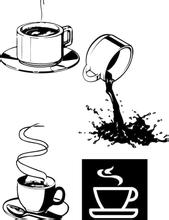Introduction of Flavor and Taste Coffee beans in Coffee Variety producing area of Santa Barara Manor in Honduras
In the 4th and 7th century, western Honduras was one of the centers of Mayan civilization. Columbus arrived in the Gulf Islands of Honduras in 1502, which was the beginning of Honduras's contact with Europe. Spanish troops began to conquer Honduras in 1524 and became a Spanish colony in the same year. In 1537-1539, Limpilla led 30,000 Indians in an uprising against Spanish colonial rule. In 1539, Honduras was placed under the jurisdiction of the Governor of Guatemala.
Honduras declared its independence on September 15, 1821, but was incorporated into the first Mexican Empire in 1822. He joined the Central American Union in 1823 and withdrew from the Central American Union in October 1838 to establish a republic. In 1840, with the support of Guatemalan dictator Rafael Carrera, conservative Francisco Ferreira established a dictatorship. After 1853, liberals and conservatives in Honduras often had coups and civil wars, and the regime changed frequently. The gold and silver mining industry has been damaged, which has greatly affected the economic development. Since the 1840s, Britain occupied eastern Honduras and the Baya Islands and built railways And the lease of large tracts of land in Honduras is divided into 18 provinces: Atlantida, Cologne, Komayagua, Copan, Cortez, Cholutka, El Palaiso, Francisco Morasan, Gracias Adios, Intibuka, Gulf Islands, La Paz, Lompilla, Ocotepec, Olanjo, Santa Barbara, Barre, The flag of Joro Honduras was launched on January 18, 1949. The national flag is rectangular with a ratio of length to width of 2:1. From top to bottom, the flag consists of three parallel rectangles: blue, white and blue. There are five blue five-pointed stars in the middle of the white rectangle. The color of the national flag comes from the color of the original Central American federal flag. The upper and lower blue wide stripes symbolize the Pacific Ocean and the Caribbean respectively; white symbolizes the pursuit of peace; and the five five-pointed stars were added in 1866, expressing the desire of the five countries that make up the Central American Federation to unite again.
Honduras is a mountainous country in Central and North America, with a population of more than 8.3 million and an area of about 112000 square kilometers. Located in the north of Central America. It is bordered by the Caribbean Sea to the north, the Gulf of Fonseca in the Pacific Ocean to the south, Nicaragua and El Salvador to the east and south, and Guatemala to the west. More than 3/4 of the territory are mountains and plateaus. Mountains extend from west to east, inland for lava plateaus, multi-mountain valleys, coastal plains. Tropical climate, coastal plain belongs to tropical rain forest climate.
Its Honduran coffee comes from El Salvador. Coffee production was lukewarm at first until the frost in Brazil in 1975. At that time, Brazil was badly hit and coffee production plummeted, while Honduras took the opportunity to "take the top". Coffee production soared from 500000 bags to 1.8 million bags and was ransacked. It was only after that that coffee production in Honduras really developed.
For coffee production, the geographical conditions of Honduras are no less than those of its neighboring coffee-producing countries such as Guatemala and Nicaragua. There are 280000 hectares of coffee plantations in Honduras, mainly small coffee plantations, most of which are less than 3.5ha. These coffee plantations account for 60% of the total coffee production in Honduras.
In the coffee garden, because the planting area belongs to the mountain area, people pick coffee beans by hand, and then process them carefully in order to produce better quality coffee beans. Honduras collects 3 million bags of coffee every year and provides you with a variety of coffee. Now it has become one of the top ten coffee exporters in the world. When it comes to Honduran coffee, many people may feel very strange. Is there coffee in Honduras? In my impression, this is one of the most restless countries in China and the United States, and the current political situation is still very unstable. The only thing that can be connected with it is the world-famous diving resort, the Honduran Blue Cave. Coffee? Will there be coffee production in such a chaotic country? However, it is true that Honduras produces coffee, and the production of coffee is still very high, and the quality of coffee is quite good.
Medium or shallow acidity, giving the impression of obvious but not strong. Sometimes it has a beautiful floral or fruity aroma (generally speaking, beans produced in different regions and at different elevations have different performances). It is not at all associated with the unrest of the country. Bitterness and obvious sweetness. The overall taste of Honduran coffee is balanced, sour and bitter are not so strong, and there is a good balance between the two.
The extremely balanced nature of Honduran coffee makes it a wide range of uses. Can be used to mix coffee, can also be used as a single product to brew, mixed with Honduran coffee Italian concentrate will have a surprising effect. Although in troubled times, coffee can also grow its own wonderful, it is not difficult to understand why so many people are so obsessed with this black liquid, to some extent, this is not a simple love or habit, coffee is a mood or rely on it. I hope this country will show its vitality and splendor as coffee as soon as possible. Tumultuous Honduras will have a future as wonderful as Honduran coffee.

Important Notice :
前街咖啡 FrontStreet Coffee has moved to new addredd:
FrontStreet Coffee Address: 315,Donghua East Road,GuangZhou
Tel:020 38364473
- Prev

Sumatra Lindongla Sunawana Manor Coffee Variety production area Flavor Coffee introduction
The topography of Sumatra is long and narrow. The topography of Sumatra is mainly from northwest to southeast of the island's Bali Mountains Barisan Mountains and the eastern lowlands. The mountains stretch, with more than 90 volcanoes and many volcanic lakes, volcanoes provide fertile soil suitable for coffee growth. For the tropical rain forest climate, high temperature and rainy all the year round. Sumatra is the largest producer of coffee in Indonesia.
- Next

Introduction of boutique coffee beans in El Salvador Renas Manor Coffee Variety producing area
El Salvador's domestic topography is mainly mountainous, plateau, volcanic, known as the country of volcanoes, Santa Ana active volcano 2385 meters above sea level, the highest peak in the country; the northern part of the country is the Lompa Valley and the southern part is the narrow coastal plain. The national emblem of El Salvador was used on September 15, 1912. The national emblem of El Salvador is an equilateral triangle with three triangles.
Related
- Does Rose Summer choose Blue, Green or Red? Detailed explanation of Rose Summer Coffee plots and Classification in Panamanian Jade Manor
- What is the difference between the origin, producing area, processing plant, cooperative and manor of coffee beans?
- How fine does the espresso powder fit? how to grind the espresso?
- Sca coffee roasting degree color card coffee roasting degree 8 roasting color values what do you mean?
- The practice of lattes: how to make lattes at home
- Introduction to Indonesian Fine Coffee beans-- Java Coffee producing area of Indonesian Arabica Coffee
- How much will the flavor of light and medium roasted rose summer be expressed? What baking level is rose summer suitable for?
- Introduction to the characteristics of washing, sun-drying or wet-planing coffee commonly used in Mantenin, Indonesia
- Price characteristics of Arabica Coffee Bean Starbucks introduction to Manning Coffee Bean Taste producing area Variety Manor
- What is the authentic Yega flavor? What are the flavor characteristics of the really excellent Yejasuffi coffee beans?

